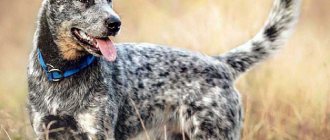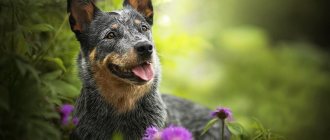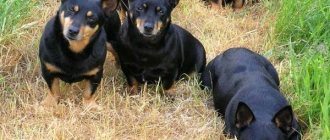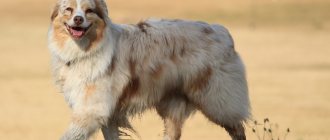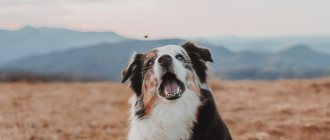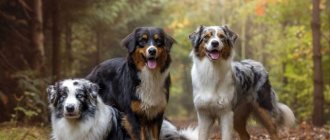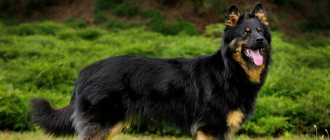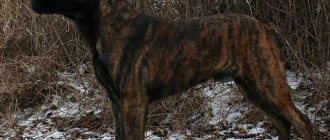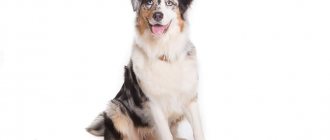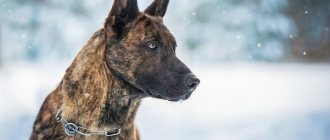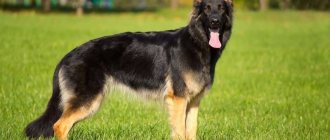The Australian Cattle Dog combines the blood of the unruly, aggressive dingo and the calm, measured blue merle. Thanks to the genes of the wild Australian, heelers easily and quickly adapted to the difficult Australian landscape, and due to the genetic heritage of the Englishman, they became docile and trainable.
Australian Cattle Dog
Breed characteristics
| Short description | |
| Origin: | Australia |
| Conditions of detention: | In a private house in the countryside, with a large garden |
| Purpose: | Companion dog, herding dog, rescue dog, caregiver dog |
| Color: | Dark gray with blue combined with red, blue with black, red with white. Most dogs have a white patch on their forehead called a "Bentley" |
| Wool length: | Average |
| Adult dog size: | The height of females is 43 – 48 cm, males 46 – 51 cm, weight of males 16 – 23 kg, females 12 – 18 kg. |
| Average life expectancy: | 12 – 16 years old. There have been cases where a dog lived to be 29 years old. |
| Walk: | Daily, more than 3 hours |
| Physical activity needs: | High demands for physical and mental activity (daily training for more than 3 - 4 hours a day). |
| Fédération Cynologique Internationale (FIC) classification: | Breed outside the FCI classification, recognized by AKC, CKC, KC(UK), UKC, ANKC, NZKC |
| Puppy price: | From 10,000 to 50,000 rubles |
Colors
There are several types:
- Red.
Uniform red speckling throughout the body and undercoat (not cream or white). There may be red spots of a darker color on the head. The presence of uniform markings on the head is desirable. Red markings on the body are acceptable, but are considered a fault. - Blue.
May be with or without spots. Specks in the head area of black, blue, and fawn colors are allowed. The presence of a fawn undercoat is acceptable if it does not protrude from the top coat. The disadvantage is the presence of black marks on the body.
History of the origin of the species
The development of the Australian Heeler breed was of a practical nature. After settlers and former prisoners of hard labor from England began to develop Australian lands - the state of New South Wales. The British turned the uncultivated Australian lands into cattle breeding. Shepherds needed a helper dog, so they began to import breeds from the shores of Foggy Albion to the continent. The hot climate was difficult for the dogs to tolerate, which affected their performance and vitality.
Attempts by breeders to cross various breeds with the Australian dingo dog were unsuccessful. Farmers were not satisfied with dogs with high aggression and low endurance.
The perfect combination of dingo and collie resulted in the Australian Cattle Dog breed. Later, to increase positive qualities, farmers crossed the heeler with the following breeds: Dalmatian and Australian Kelpie.
The Australian Heeler is a working dog, adapted to life in the humid subtropics, and is very popular on the distant continent.
The breed was officially recognized by dog breeders around the world and registered with the dog handlers association in 1972.
In America, healers appeared after the Second World War, in Europe in the 80s of the last century. Russian breeders began to be interested in the breed only in the early 2000s.
Health, illness
The gene pool of these dogs is extremely strong. Perhaps thanks to the genes of the wild dingo dog, these shepherd dogs are one of the hardiest and most resistant to various diseases. In addition, dogs of this breed are among the longest-livers. An Australian heeler named Blue is listed in the Guinness Book of Records as the “oldest dog” in the world. This dog lived for 29 years, 5 months and 7 days (06/07/1910 - 11/14/1939), of which she devoted 20 years to her work - tending herds. Of course, for your dog to be healthy, you need to take care of him. The healer needs to spend a lot of time outdoors.
These dogs are created to herd and move herds. Therefore, they need intense exercise every day for their physical and emotional health. Before purchasing a puppy of this breed, be sure to study its heredity. In rare cases, dogs can be born with deafness, epilepsy, hip dysplasia and eye diseases.
Distinctive features
The main parameters characterizing the Australian Cattle Dog:
- The head is similar to its progenitor - the dingo. The muzzle is not long, but wide.
- Ears do not have a specific standard. There are large, medium and small. They do not adjoin each other, they are always level and in a standing position.
- The tail is short and thick, used when running for better aerodynamics.
- The eyes are neat, not large, and have a brown color. The look contains the mischief of a wild dog, passed down from its ancestors.
- The body structure is not bulky, athleticism is present due to its playful character and mobility.
- The wool is double-layered for good body thermoregulation.
- The lips and nose, as a distinctive feature of the breed, are black.
- bite - originally used to bite livestock on the lower limbs.
Photo of an adult Australian Heeler dog
Photos of Australian Heeler puppies
Features of character and behavior
The Australian Cattle Dog is a breed that has endless energy. The activity in action is simply incredible. It is not surprising that for the shepherds on the Australian continent, there was no better friend and helper. The ability to independently monitor the herd and make instant decisions has been recommended as the best working breed.
Advantages
The advantages of the Australian Heeler include:
- Intelligence – the breed is positioned as one of the smartest and is included in the top 10 in the world.
- Pets are very affectionate and gentle towards their owner. They try in every possible way to please, to do everything right, in order to receive praise in return.
- They respond well to training. Thanks to their innate organizational abilities and mental development, dogs achieve good results, which are assessed with the highest scores at competitions and exhibitions.
- They love children . The main criterion of Australian breeders when breeding the breed is based on the fact that the heeler must get along and treat children with care. If contact is not established, mating is prohibited.
- Curiosity and sense of humor. The dog will be delighted if he sees something that can make his owner laugh or please. Curiosity manifests itself constantly, this is facilitated by innate mobility.
- Dimensions and health. The object does not belong to the category of large dogs, transportation will not cause inconvenience. The breed is famous for its strength and excellent health.
- There are no whims with food. A working dog, he will eat what he gives.
Flaws
There are only a few disadvantages:
- Heeler sees an authoritative leader in only one person. He treats other family members with respect, but does not allow complete submission. A new personality for a dog is an object for research and adaptation.
- Beginning breeders should not adopt this breed. Only experienced, avid dog breeders will be able to cope with the wayward, moderately wild character of the pet.
- The Australian Heeler will not live long without a purpose ; with dull, passive activity, he will simply wither away.
- The owner must completely get rid of the idea of putting the pet on a chain; this type of restriction is unacceptable for the breed .
Nutrition
The wild ancestry and proximity of the Kettle Dog genes with primitive dingoes creates a number of specific dietary restrictions. The essence of these restrictions is that the body of a purebred dog does not accept foods that were not in the diet of its parents. It is best to give your dog raw, lean meat and milk porridge. In this case, meat products should make up 50% of the diet.
Among the prohibitions are the following: potatoes, baked goods, sugar, yeast, mushrooms, onions, garlic, spices. Eating foods with a high percentage of simple carbohydrates can lead to the development of cancer of the gastrointestinal tract.
Care and maintenance
The Australian Heeler is absolutely not a fan of the urban jungle. The dog was bred to protect the herd, so the modern pet needs physical exercise and walking. Lack of movement will lead to aggression, weight gain and moodiness.
A plot with a large area is an ideal option for a healer. Due to its innate curiosity, the dog tends to run away, so the breeder should strengthen the fences of the area well, keep gates and gates in a closed position.
Nutrition
The diet and diet of the breed does not differ from the accepted rules:
- Balanced meals twice a day should not be in large quantities. Larger portions are needed after increased loads.
- Dogs, as predators, prefer meat products, but for comprehensive development, it is necessary that the diet contains fats, carbohydrates, fiber, and vitamin supplements.
- The dog breeder must monitor the quality and freshness of the food. If the dog eats natural food, create a balanced diet menu for the day, consisting of meat, fish, vegetables and dairy products.
- Particular attention is paid to the drinking regime. The dog is active, the water bowl should always be full.
- The carbohydrate component is required in a minimal amount so as not to increase the load on the liver. Chocolate, sweets, and cookies are prohibited. Pickled, spicy, salted and smoked products are also contraindicated. The animal's enzyme system is not adapted to digest such food.
- Purchase factory-made feed from trusted suppliers, pay attention to the composition, date and place of manufacture. The minimum amount of stabilizers and additives is the key to your pet’s health.
Mother's milk serves as food for newborn puppies. The general diet is introduced from 2 months of age. Complementary feeding begins with curd protein and fermented dairy products. The next step is to introduce meat protein (in the form of minced meat) with vegetables. Puppies are transferred to a standard feeding regimen at six months of age.
Health
The Australian Cattle Dog is an energetic, very active and healthy breed. It easily adapts to living conditions and is famous for its lack of whims.
Genetically transmitted traits are acceptable for any breed. When choosing a pet and planning to breed puppies, it is necessary to carefully study the pedigree and diseases inherent in the breed.
Vaccinations
When purchasing a puppy, the seller provides the buyer with a veterinary passport for the pet. It reflects all vaccinations received. Next, the owner takes upon himself to vaccinate the dog, according to the vaccination schedule.
Before the procedure, the doctor conducts an examination, and the owner is notified of possible consequences (allergic reactions). Early anthelmintic therapy is required. The dosage is selected by an experienced veterinary specialist.
The main stage of mandatory vaccination is carried out during 1 year of the pet’s life and includes vaccinations against:
- Rabies – done at 3 months of age.
- Parovirus enteritis - done at 2 months of age.
- Distemper - done at 2 months of age.
- Leptospirosis - done at 2 months of age.
After the procedure, the pet becomes weak and the temperature may rise. You should refrain from walking for 2 weeks, especially avoid contact with yard dogs. Swimming and sudden changes in diet are prohibited.
The breeder plans revaccination when the puppy turns 1 year old; complex vaccines that produce antibodies to several diseases at once are allowed.
Diseases
The Achilles heel of the breed is:
- Eyes – retinal dysfunction, cataracts, lens luxation (lead to blindness);
- Joints – dysfunction of the hip, elbow, ankle joints (immobilization);
- Ears – deafness.
Worms will cause a lot of trouble for the owner, so you need to have approved anthelmintic drugs in your medicine cabinet.
To diagnose and prevent the disease, your pet should be regularly taken to the veterinarian for examination.
Walk
Owners who prefer indoor gatherings should refrain from purchasing this breed. The Australian Heeler cannot live without active walks, which take more than 3 hours. Running, jumping, and mental exercises will direct the pet’s innate excessive energy in the right direction.
Grooming
Taking care of the appearance will not be a hassle. Pet hygiene consists of periodic brushing and cleaning of the ears. Carry out bath procedures occasionally, as they become dirty.
Feeding
Your dog's daily diet should include the following raw foods: meat, sea fish, offal. The following must be added to food:
- low-fat cottage cheese;
- cereals (buckwheat, oatmeal, rice);
- greens and vegetables (beets, zucchini, carrots).
It is strictly forbidden to feed your pets table scraps. The diet should not include barley and wheat porridge, garlic, onions, potatoes, smoked meats, mushrooms, pastries and sweets. Flaxseed oil, fish oil, and seaweed (spirulina) should be added to food in small quantities. Owners need to control portion sizes, as representatives of this breed are prone to rapid weight gain.
Mating
Mating must be taken very seriously in order to get healthy offspring:
- Before the procedure , be examined by a veterinarian and take genetic tests. Unfortunately, if the dog is a carrier and especially a carrier of a disease that will affect the offspring, mating is prohibited. Various crossing options are considered when there is a high probability of the birth of healthy puppies. The breeders are responsible in each case.
- Heeler individuals that have reached 1.5 years of age . Bitches go into heat in the autumn and spring. It is customary for owners to breed a pair on the 2nd or 3rd heat and 8–10 days after the start.
- Mating takes place traditionally in the male dog's territory . If the male does not recognize the female and shows aggression, the procedure is repeated every other day. The best time of day for mating is morning.
- After proper mating and three months of gestation, puppies appear. The quantitative component of the litter is 1 – 7 pieces.
Key points in training
The dingo's wild nature and activity are not an obstacle to training. The Australian Heeler's desire to please its owner takes precedence over its instincts. Your pet will be happy to follow commands during training courses. Independent organization of training should include loads of various types. Likes to do exercises where you have to think, loves praise very much. The dog will see the owner as a leader who must be obeyed and obeyed.
Training should not be accompanied by violence. The owner calmly presents the established rules. In case of disobedience or mischief, carefully move the puppy away (like the mother) and speak in denial.
The instinct, passed down from descendants - shepherds, to bite the legs, is eliminated by pointing out to the puppy that this cannot be done, but not by shouting or aggressive actions.
With proper organized training, the pet is unlikely to damage the owner's personal belongings. This is facilitated by conversations and explanations of the owner, in whom the healer sees an authoritative person.
Read about how to properly train a dog in the article: “Training a puppy: effective methods from dog handlers, learning commands at home.”
It is important to know!
If you decide to get an Australian Heeler that you intend to keep in your yard, then be prepared for regular escapes. These dogs are incredibly inquisitive, they will instantly explore the entire territory and will definitely find a loophole through which they can escape from a confined space. They often dig under a fence or gate. Such behavior can seriously puzzle any person, but, as a rule, healers always return home, as they are very attached to their owner.
How to choose a puppy
The breed is not very common in Russia and there are several options for purchasing puppies:
- In the nursery. The most reliable option. There is a caveat: to get a purebred Australian Heeler, you will have to wait in line, but the future owner will be confident in genetic purity.
- At exhibitions and by advertisement. It is advisable for a breeder planning a purchase to choose together with an experienced dog breeder, so as not to run into deception.
The criteria for purebredness and genetic purity of this breed include:
- Puppies are always born white with black spots; gradually the color turns to reddish or gray-blue.
- Lips and nose are only black.
- Scissor bite of the jaw. Missing teeth are a sign of a defect.
- Eye color is always shades of brown. Blue eyes in puppies are also recognized as a defect.
Now we know what kind of breed the Australian Cattle Dog is. Due to the high cost and low prevalence in the country, you should not rush to the first option. You should contact experienced breeders directly before purchasing and evaluate the pros and cons of keeping a pet of this breed.
4.6 / 5 ( 5 votes)
Tenterfield Terrier
The ancestors of Tenterfields were Fox Terriers that arrived in Australia from Europe. The settlers took the smallest individuals onto the ship to catch rats in inaccessible places on the ship.
Miniature Fox Terriers spread across the continent and were crossed with other small dogs. The dogs were called mini-foxies and were considered a breed of smooth fox terriers.
Targeted selection began in 1993. Popular Australian TV presenter Donald Burke suggested renaming the Mini Foxy Tenterfield Terrier, and dog owners opened their own club.
Now the breed is developing. In 2002 she was recognized by the national dog breeding council ANKC. Other organizations are still looking closely.
Tenterfield Terriers are small, smooth-haired dogs with a height of 22 to 30 cm. The coat is smooth, short, and close-lying. The main color is white with brown, black, red or blue spots. Sometimes the markings are multi-colored.
Tenterfield Terriers behave confidently, move a lot, love to learn and please their owner. They treat domestic animals peacefully, but do not obey well those who are not considered leaders.
